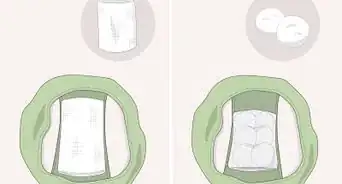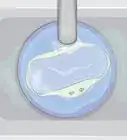This article was co-authored by wikiHow Staff. Our trained team of editors and researchers validate articles for accuracy and comprehensiveness. wikiHow's Content Management Team carefully monitors the work from our editorial staff to ensure that each article is backed by trusted research and meets our high quality standards.
There are 18 references cited in this article, which can be found at the bottom of the page.
wikiHow marks an article as reader-approved once it receives enough positive feedback. This article received 18 testimonials and 90% of readers who voted found it helpful, earning it our reader-approved status.
This article has been viewed 3,137,821 times.
Learn more...
A menstrual cup collects menstrual fluid instead of absorbing it. You clean and reuse it, which means you don't need to replace it for a long time. Most people find they leak less than tampons and are more comfortable to wear. To use one, you'll insert it into your vaginal opening and twist it to make sure it sits right. Then, you can leave it in for as long as 12 hours before taking it out and emptying it. It may take time and practice to get used to using one, but menstrual cups are a highly sanitary and eco-friendly means of dealing with your period.
Steps
Inserting a Menstrual Cup
-
1Purchase a menstrual cup online or in a drug store. Menstrual cups are becoming more popular, so you should be able to find them in most drug stores and big box stores. Some are a bit smaller or larger, so it's always good to read reviews before deciding on one.[1]
- For instance, you can try the Diva Cup, the Softdisk, Softcup or the Lunette.
- Menstrual cups run $30-$40 USD, but keep in mind that you can use them over and over.[2] However, you can get them cheaper, usually in the $7-$10 USD range on the low end, so look around if you just want to try one out.[3]
- Menstrual cups are typically made of silicone or rubber. If you have latex allergies, make sure the cup you choose is made completely with silicone.[4]
-
2Read the instructions accompanying your menstrual cup. Instructions can differ from cup to cup, so it's always a good idea to read what comes with your cup! That way, you know just what you should do with yours.Advertisement
-
3Wash your hands thoroughly before touching the cup. You should wash your hands any time you're using products around your vaginal area, as you don't want to introduce bacteria. Use warm water and soap, making sure you scrub for at least 20 seconds before rinsing.[5]
- You can sing the "Happy Birthday" song slowly to yourself to estimate 20 seconds.
-
4Wash your cup with a mild soap before using it the first time. Most companies will ask you to wash it before you put it in. Pick a fragrance-free soap labeled for sensitive skin. Thoroughly rub the cup inside and out with the soap and warm water, and then rinse the soap off completely.
-
5Get into a position that feels comfortable to you. Some people prefer to squat, while others find balancing one leg up higher works well. You can even just sit on the toilet, spreading your legs apart.[6]
- Set aside a little time to insert your cup the first time you do it. It may take some trial and error. You can even do it in a warm shower to help relax you.[7]
-
6Fold the cup to make it easier to insert. You can try the c-fold, where you squeeze the opening together then fold the opening in half. You can try the 7-fold, which is similar, but you bring one edge up higher, making the cup a bit narrower. Another option is the punch-down fold. Hold the cup between your thumb and middle finger, then press one edge down with your index finger, pushing it in toward the center of the cup.[8]
- You can't put it in without folding it, as the suction will work against you. Try out different folds and see which one works best for you.
- You can also wet the cup slightly to make it easier to slide in.
- Make sure the stem is facing downward and the bowl is facing upward.
-
7Relax your muscles as much as you can. Take a few deep breaths. If you're nervous, you'll tense up, and that will make it harder to insert. Try tensing your vaginal muscles for a moment and then releasing them.[9]
-
8Push the cup back toward your tailbone. With your other hand, spread your labia (lips) apart. Gently press the folded cup into your vaginal opening, moving more front to back than upward. Release the fold and let the cup move into place.[10]
- Typically, the cup won't go as high as a tampon, though you can push it higher if you'd like. Some cups are made to go higher, so always read the directions for yours.
- If it doesn't feel right, try inserting it again to see if it feels more comfortable.[11]
-
9Twist the cup to make sure it seals. Grab the base of the cup by the sides (not the stem) and turn it at least 1 full rotation. This will help ensure that the sides pop out completely to create the seal.[12]
- You may hear or feel a "pop," which is a sign that the cup has opened. If you're not sure, reach up and feel around the base of the cup. It should be round or oval, depending on your body shape.
- If it hasn't opened, pull lightly down on the stem without actually pulling the cup out.
Taking the Cup Out
-
1Check the cup every 12 hours. Most of the time, you can get away with leaving the cup in for 12 hours. That means you only have to empty it in the morning and at night, which you can do in the comfort of your home.[13]
- If you have a particularly heavy period, you may need to empty it more often.
-
2Sit over a toilet to take the cup out. While some women need to take it out standing up, you should try it over a toilet. It can be messy if you don't have the technique down yet. Don't worry, though. Once you figure out the best way for you to remove it, it tends to make very little mess at all![14]
-
3Pull the cup out by breaking the seal first. You can't just yank the cup out, as suction will be working against you! Instead, grab the base of the cup just above the stem and pinch the sides together. That should break the seal enough for you to pull it out. Make sure to keep it upright as you pull it out.[15]
- If that doesn't break the seal, try moving one finger over the rim of the cup.[16]
- Don't worry if you can't get it out on your first try! It can't get "lost" in your vagina; your vagina doesn't work that way. Take a moment, relax, and then try again.
-
4Empty the cup into the toilet. Continue to keep it upright as you move it toward the toilet, and then turn it over to dump out the contents. If you can't wash it out right then, you can simply wipe it off with toilet paper and re-insert it.[17]
- Be careful not to drop it in the toilet! If you do, make sure to wash it thoroughly before putting it back in.[18]
-
5Wash your cup with soap and water. If possible, rinse the cup out in the sink. Then, rub it down with soap and warm water, making sure to use running water to get all the soap off. Then, you can put the cup back in.[19]
- It's best to use a mild, unscented soap.
- If you have a disposable cup, toss it out and put in a new one.
Cleaning Your Cup and Troubleshooting
-
1Sterilize the cup between periods by boiling it. Wash the cup out with soap and water. Then, bring water to a boil in a small pan. Place it in the pan, and boil it for 5-7 minutes to sanitize it. You'll likely want to keep a separate pan just for this purpose.[20]
- If the cup is stained, use 70% rubbing alcohol on it.
- You can also clean it with a sterilizing solution, like what you would use for baby bottles. You can find these solutions with the baby bottle supplies in big box stores.[21]
- Always read the directions for your cup about sterilization, as the process can differ from cup to cup.
-
2Cut part of the stem off if it bothers you. For some people, the stem on the cup is too long and causes irritation. If that's true for you, you can simply snip part of it off with most cups, making the fit more comfortable.[22]
- You can also just purchase one with a shorter stem.
-
3Try out different cups if your first one doesn't feel right. Not every cup is going to fit every person! That's why there are different ones out there. If you find yours to be uncomfortable, consider trying another one to see if that's a better fit.[23]
- For instance, you can get a smaller cup, one with a shorter stem, or one made for people who are more sensitive.
- Some even come in different shapes! For instance, some cups are more angled than others.
-
4Get a cup designed for a heavy flow if you're leaking. While accidents do happen, you shouldn't leak in a cup most of the time, as long as you make sure to get the seal right. However, if you're consistently overflowing your cup and you can't or don't want to check it more often, try out one made for a heavier flow. It will hold more liquid, making it less likely to overflow.[24]
-
5Stretch your hymen and vaginal opening if you find the area is too tight. If you haven't had sex or used a tampon, you may find that your vaginal opening and the hymen do not easily stretch to accommodate a cup. If this is the case, try stretching the area over the course of a month or so using your fingers. Start with 1-2 fingers and increase to 3 as your body will allow. You could also use a small dildo. Don't do too much too fast. If it's painful, stop and ease back to a point where it wasn't painful.[25]
- Keep in mind, the hymen doesn't completely cover your vaginal opening, except in very rare cases, which should be corrected with surgery. Rather, it's a membrane that goes partially around your vaginal opening that should stretch some if it's too tight. Your hymen isn't an indicator of whether you're a virgin or not. Though it can stretch over time, it's not something you break through to get to your vagina, and it can be different shapes or sizes depending on the person.[26]
Warnings
- On heavier days, a full cup can leak; wearing back-up pads and emptying your cup more often on these days can help.⧼thumbs_response⧽
- Menstrual cups are not a form of contraceptive and most should be removed before sexual intercourse. However, disposable soft cups can be used during sex along with a contraceptive.⧼thumbs_response⧽
References
- ↑ https://www.teenvogue.com/story/menstrual-cups-everything-you-need-to-know
- ↑ https://www.shape.com/lifestyle/mind-and-body/how-to-use-menstrual-cup
- ↑ https://www.cosmopolitan.com/sex-love/a13126155/best-menstrual-cups/
- ↑ https://health.clevelandclinic.org/tired-of-tampons-here-are-pros-and-cons-of-menstrual-cups/
- ↑ https://www.plannedparenthood.org/learn/health-and-wellness/menstruation/how-do-i-use-tampons-pads-and-menstrual-cups
- ↑ https://www.plannedparenthood.org/learn/health-and-wellness/menstruation/how-do-i-use-tampons-pads-and-menstrual-cups
- ↑ https://www.teenvogue.com/story/menstrual-cups-everything-you-need-to-know
- ↑ https://www.shape.com/lifestyle/mind-and-body/how-to-use-menstrual-cup
- ↑ https://www.plannedparenthood.org/learn/health-and-wellness/menstruation/how-do-i-use-tampons-pads-and-menstrual-cups
- ↑ https://www.shape.com/lifestyle/mind-and-body/how-to-use-menstrual-cup
- ↑ https://www.plannedparenthood.org/learn/health-and-wellness/menstruation/how-do-i-use-tampons-pads-and-menstrual-cups
- ↑ https://www.teenvogue.com/story/menstrual-cups-everything-you-need-to-know
- ↑ https://health.clevelandclinic.org/tired-of-tampons-here-are-pros-and-cons-of-menstrual-cups/
- ↑ https://www.shape.com/lifestyle/mind-and-body/how-to-use-menstrual-cup
- ↑ https://www.shape.com/lifestyle/mind-and-body/how-to-use-menstrual-cup
- ↑ https://www.plannedparenthood.org/learn/health-and-wellness/menstruation/how-do-i-use-tampons-pads-and-menstrual-cups
- ↑ https://www.plannedparenthood.org/learn/health-and-wellness/menstruation/how-do-i-use-tampons-pads-and-menstrual-cups
- ↑ https://www.teenvogue.com/story/menstrual-cups-everything-you-need-to-know
- ↑ https://www.plannedparenthood.org/learn/health-and-wellness/menstruation/how-do-i-use-tampons-pads-and-menstrual-cups
- ↑ https://www.shape.com/lifestyle/mind-and-body/how-to-use-menstrual-cup
- ↑ https://health.clevelandclinic.org/tired-of-tampons-here-are-pros-and-cons-of-menstrual-cups/
- ↑ https://www.shape.com/lifestyle/mind-and-body/how-to-use-menstrual-cup
- ↑ https://www.cosmopolitan.com/sex-love/a13126155/best-menstrual-cups/
- ↑ https://www.cosmopolitan.com/sex-love/a13126155/best-menstrual-cups/
- ↑ http://sexted.org/faq/all-about-the-hymen/
- ↑ http://sexted.org/faq/all-about-the-hymen/
About This Article
A menstrual cup is a reusable alternative to sanitary products like pads or tampons. To use your cup, clean your hands with warm water and soap to wash away germs and dirt. You should also wash the cup with mild soap and water and rinse it thoroughly. When you’re ready to insert the cup, squat, stand with one leg propped up, or sit on the toilet with your knees apart. Pinch the cup to fold the sides in, then relax your muscles, spread your labia with your other hand, and slide the cup into your vagina, open end up. If it doesn’t feel comfortable, pull it out and try again. Some cups are meant to sit higher up in your vagina than others, so read the directions that come with your cup. Grab the cup by the base and give it a twist to make sure it pops open and creates a seal. When you’re ready to take the cup out, sit on the toilet, grab the base of the cup, and pinch the sides together to break the seal. After you slide it out, empty it into the toilet. For your safety, wash the cup with soap and water any time you change it, and disinfect it by boiling it in water for 5-7 minutes between periods. To learn how to troubleshoot common problems with your menstrual cup, read on!

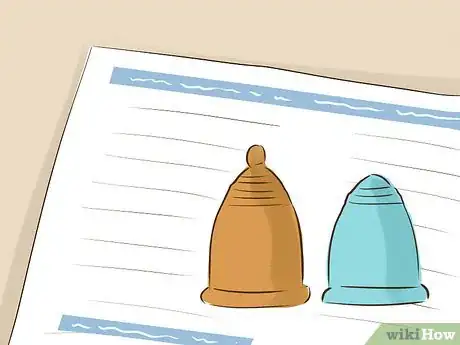

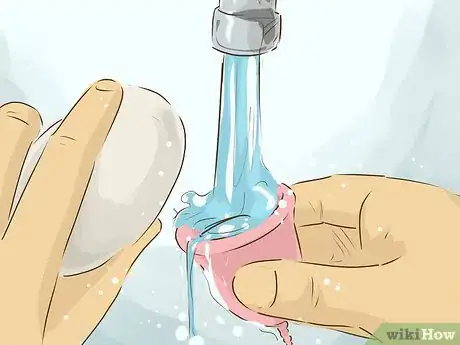



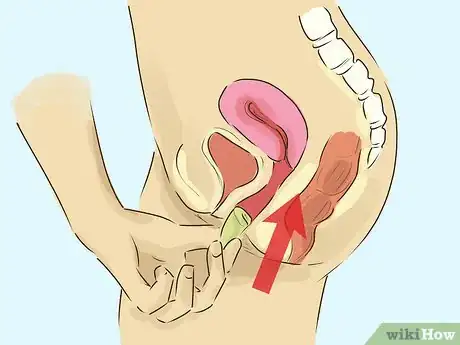
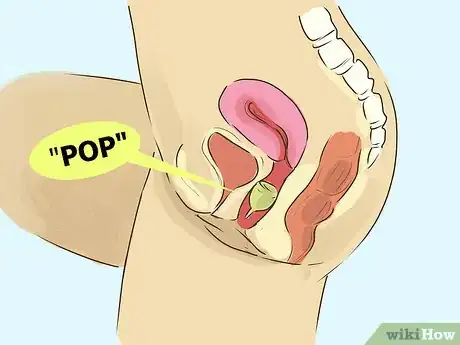


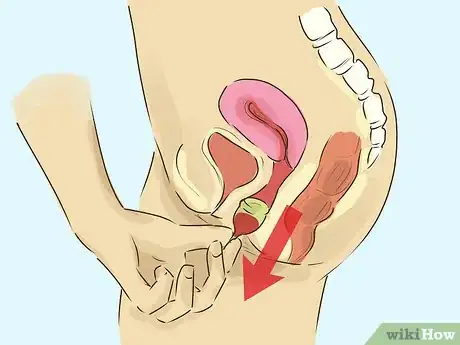


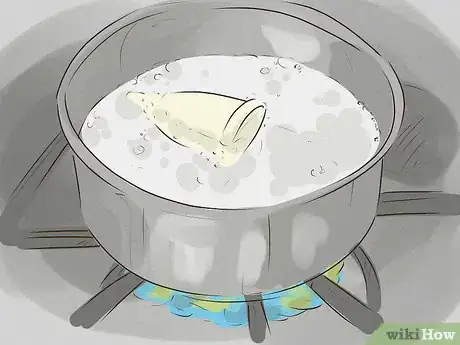
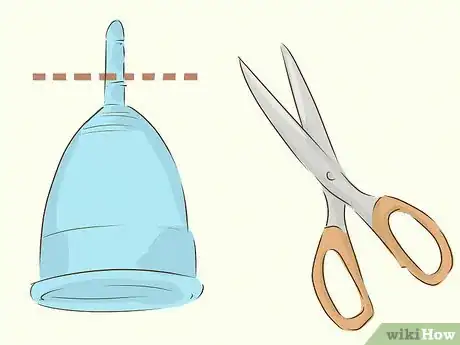


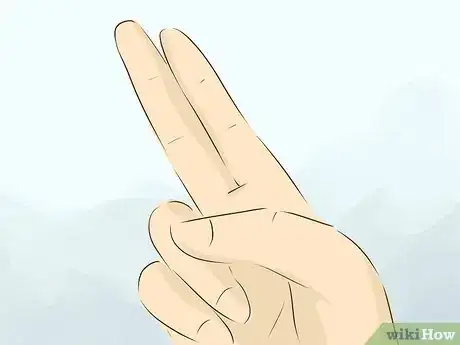










-Step-14.webp)
